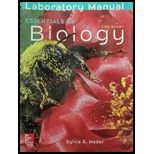
Concept explainers
To determine:
The reasons meiosis sometimes is referred to as reduction division.
Introduction:
Cell division is a process through which cell is divided and make new cells. The process is classified into two types, they are mitosis and meiosis. Mitosis is also known as vegetative division, in which daughter cells is identical to the parent cell and as well as to each other. Meiosis is also known as reproductive division, in which the daughter cells are not identical to the parent cell in their genetic constitution.
Explanation of Solution
Meiosis is a type of cell division that results in
Meiosis is termed as reduction division because it reduces the number of chromosome in the daughter cell. In this division, the diploid parent cells divide to form haploid cells. After chromosome duplication during cell cycle, the two meiotic divisions are as follows:
Meiosis-I, homologous chromosomes pair up and separate, resulting in two haploid with replicated chromosomes (reductional division).
Meiosis-II, sister chromatids separates (equational division).
The reductional division in Meiosis-I results in 4 daughter cells from a single parent cell. Each daughter cell receives half of the number of chromosomes present in the parent cell.
Meiosis is also known as reduction division as it results in four daughter cells with half the number of chromosomes from a single parent cell.
Want to see more full solutions like this?
Chapter 9 Solutions
Lab Manual for Essentials of Biology
 Human Anatomy & Physiology (11th Edition)BiologyISBN:9780134580999Author:Elaine N. Marieb, Katja N. HoehnPublisher:PEARSON
Human Anatomy & Physiology (11th Edition)BiologyISBN:9780134580999Author:Elaine N. Marieb, Katja N. HoehnPublisher:PEARSON Biology 2eBiologyISBN:9781947172517Author:Matthew Douglas, Jung Choi, Mary Ann ClarkPublisher:OpenStax
Biology 2eBiologyISBN:9781947172517Author:Matthew Douglas, Jung Choi, Mary Ann ClarkPublisher:OpenStax Anatomy & PhysiologyBiologyISBN:9781259398629Author:McKinley, Michael P., O'loughlin, Valerie Dean, Bidle, Theresa StouterPublisher:Mcgraw Hill Education,
Anatomy & PhysiologyBiologyISBN:9781259398629Author:McKinley, Michael P., O'loughlin, Valerie Dean, Bidle, Theresa StouterPublisher:Mcgraw Hill Education, Molecular Biology of the Cell (Sixth Edition)BiologyISBN:9780815344322Author:Bruce Alberts, Alexander D. Johnson, Julian Lewis, David Morgan, Martin Raff, Keith Roberts, Peter WalterPublisher:W. W. Norton & Company
Molecular Biology of the Cell (Sixth Edition)BiologyISBN:9780815344322Author:Bruce Alberts, Alexander D. Johnson, Julian Lewis, David Morgan, Martin Raff, Keith Roberts, Peter WalterPublisher:W. W. Norton & Company Laboratory Manual For Human Anatomy & PhysiologyBiologyISBN:9781260159363Author:Martin, Terry R., Prentice-craver, CynthiaPublisher:McGraw-Hill Publishing Co.
Laboratory Manual For Human Anatomy & PhysiologyBiologyISBN:9781260159363Author:Martin, Terry R., Prentice-craver, CynthiaPublisher:McGraw-Hill Publishing Co. Inquiry Into Life (16th Edition)BiologyISBN:9781260231700Author:Sylvia S. Mader, Michael WindelspechtPublisher:McGraw Hill Education
Inquiry Into Life (16th Edition)BiologyISBN:9781260231700Author:Sylvia S. Mader, Michael WindelspechtPublisher:McGraw Hill Education





